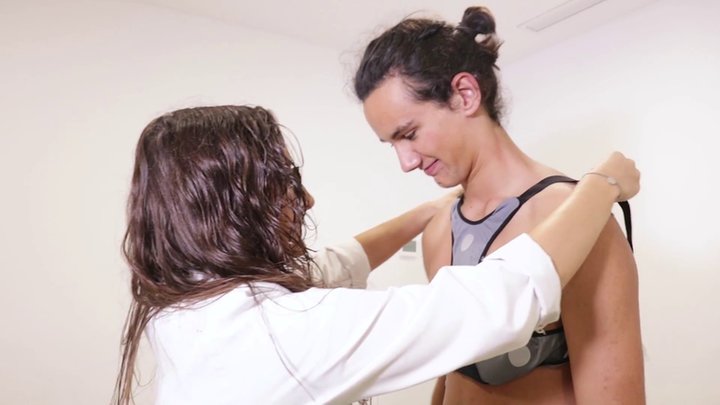By Gergana Koleva
While the U.S. footprint on the remote monitoring ECG market is by far the largest, Spain-based Nuubo is determined to show European players aren´t going to be taken out of the game. The company’s singular focus on medical electronic textiles, combining unrivalled ease of use with clinical-grade accuracy, offers the best of both worlds in the cardiac telemetry space.
Founded in 2005 with the mission of improving textile-based biosensor technology, Nuubo has “white-hacked” remote ECG monitoring by taking a deceptively simple concept and converting it into a clinically validated arrhythmia detection device. By embedding 3D-printed electrodes into an elastic fabric vest – a rather minimalist accessory that resembles an exercise belt with V-back straps attached to it and which is worn as an undergarment – it has simplified the traditional way of connecting electrodes, and in the process making cardiac monitoring almost invisible to the user.
Nuubo30, as the vest is named, is designed to cover the upper ribcage and comes with a slot right over the heart for a battery-powered two-lead ECG recorder called NuuboREC. Completing the set is the Nuubo Leonard, the software program which makes possible the download and AI algorithm-aided analysis of collected data. The system is intended for long-term monitoring of patients with suspected arrhythmia as well as those in need of post-surgery rehabilitation.
“When we started Nuubo, we just wanted to prove to ourselves that doctors will be diagnosing patients using textile and after five years selling in Europe and recording the ECGs of more than 50,000 patients, we feel very proud of being the first textile ECG system in the market,” says Nuubo´s CEO Juan Alcántara.
Reflecting on how perceptions of textile-based wearable devices have changed since then, he adds: “In the beginning the biggest barrier was not even the technology, but the unclear need for long-term monitoring. This has changed and today long-term monitoring is recommended for many clinical indications.”
Ahead of its time

Changing physician attitudes toward the need for long-term monitoring has benefitted Nuubo and affirmed its image as a bona fide cardiac ECG solution amidst a sea of consumer wearables. Aside, Alcántara points out there has been another, equally important shift in attitudes toward the distinction between clinical-grade and consumer wearables.
“On the one hand, clinical data shows more and more need for long-term monitoring and this trend has led to new technologies, but on the other, medical devices used to be separated clearly from consumer devices and this line is getting thinner when it comes to devices used in the patient´s home.”
In the case of Nuubo, this line has all but disappeared: its textile ambulatory ECG (aECG) technology has both FDA clearance and CE mark approval, and the device is being commercialized in the U.S., Europe, and Australia, while also undergoing approval in Argentina, Chile, Mexico, Peru, and Russia.
In an unusual step for a medtech company – and in a way resembling its own fluid textile sensor ECG technology – Nuubo has broken down all the walls between its product and the people it serves. On its website, it provides a health literacy lesson to visitors, walking them step by step through the mechanics and symptoms of arrhythmia and its diagnosis, prognosis, and treatment. Its didactic approach to explaining why one might be prescribed an ECG monitor and the difference between existing devices and technologies might be seen as a lesson in communication to its peers, as well.
“The way we like to discover and learn about products is not anymore through beautiful commercials or salesmen knocking on your door ten times a day. As medical device manufacturers we have a responsibility to provide accessible information to our customers and potential customers,” says Alcántara. He cites as an inspiration for his view Jay Baer´s book “Youtility: Why Smart Marketing Is About Help Not Hype” and believes it points the way to how things will increasingly be done in the future. “I think ´Youtility` will be a trend in the next years in the medical device industry,” he predicts.
Convergence in wearables
Communication approach

It was funny in the beginning, but when you know you have manufactured hundreds of units with this problem, it did not look funny anymore,
Juan Alcántara Morales, MD, CEO

Behind Nuubo´s imaginative patient-centric textile ECG monitoring device stands a team of accomplished academic researchers, industrial designers, technicians, and a manufacturing director specialized in smart fabric production. They hail from some of the most advanced companies in the health technology space, such as Boston Scientific, St Jude Medical, and Johnson & Johnson – yet Alcántara says their innovation ideas often come from the unlikeliest places. He recounts one such occasion that helped the team realize it needed to improve the ease with which the ECG recorder device is removed from the textile unit. Nuubo had tested multiple designs of the connecting tissue between the two, but it wasn´t until a product demonstration on Spanish TV a few years ago, when a member of the broadcast crew got stuck removing the recorder, that the engineers noticed the problem.
“It was funny in the beginning, but when you know you have manufactured hundreds of units with this problem, it did not look funny anymore,” confesses Alcántara, who says the company used the televised slip-up to improve its technology. “Innovation is not only in the big things like electrodes and algorithms.”
In line with this philosophy, two other “small” innovative features Nuubo has built into its product include strechable conductive tracks and adhesive-free usage. The latter, in the executive´s view, is Nuubo´s biggest advantage in the long-term cardiac monitoring space and the way of the future.
“The biggest value for patients is that our electrodes do not contain adhesives. Patients just love not having to replace the adhesive electrodes, as they can remove the device if they need to do it and put it back like a shirt. None of us wear anything attached to the body by adhesives during long-term – and non-adhesive solutions is the new direction for long-term cardiac monitoring too.”



